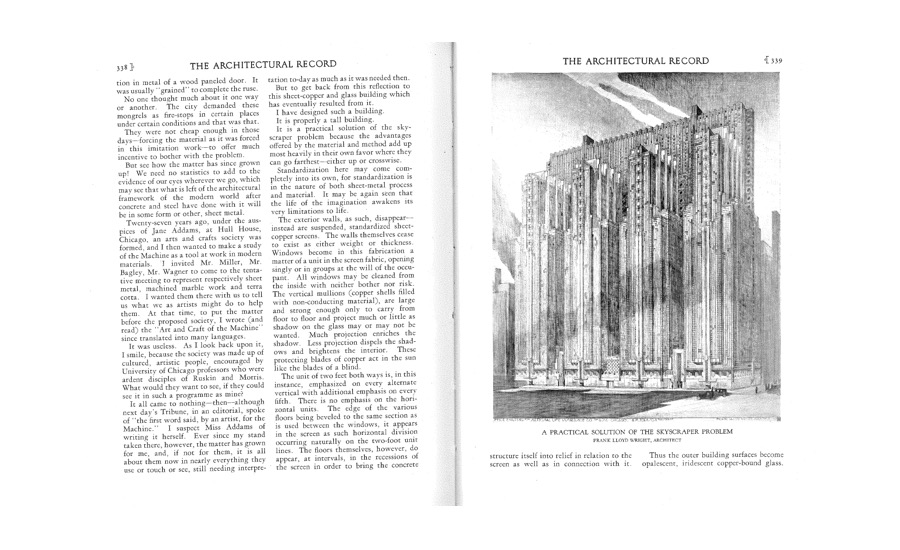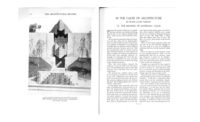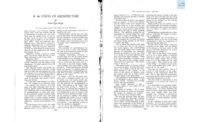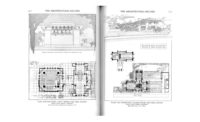Being likewise fabricated on a perfect unit system, the interior partitions may all be made up in sections, complete with doors, ready to set in place and designed to match the general style of the outer wall screen.
These interior partition-units thus fabricated may be stored ready to use, and any changes to suit tenants made over night with no waste of time and material.
The increase of glass area over the usual skyscraper fenestration is only about ten per cent (the margin could be increased or diminished by expanding or contracting the copper members in which it is set), so the expense of heating is not materially increased. Inasmuch as the copper mullions are filled with insulating material and the window openings are tight, being mechanical units in a mechanical screen, this excess of glass is compensated.
The radiators are cast as a railing set in front of the lower glass unit of this outer screen wall, free enough to make cleaning easy.
The walls of the first two stories, or more, may be unobstructed glass – the dreams of the shop-keeper in this connection fully realized.
The connecting stairways necessary between floors are here arranged as a practical fire-escape forming the central feature, as may be seen at the front and rear of each section of the whole mass, and though cut off by fire-proof doors at each floor, the continuous stairway thus made discharges upon the sidewalk below without obstruction.
The construction of such a building as this would be at least one-third lighter than anything in the way of a tall building yet built – and three times stronger in any disturbance, the construction being balanced as the body on the legs, the walls hanging as the arms from the shoulders, the whole, heavy where weight insures stability.
But of chief value as I see it is the fact that the scheme as a whole would legitimately eliminate the matter of “architecture,” that now vexes all such buildings, from field construction, all such elements or architecture “exterior” or interior becoming a complete shop-fabrication – assembled only in the field.
The shop in our mechanical era is ten to one, economically efficient over the field, and will always increase over the field in economy and craftsmanship.
The mere physical concrete construction of pylons and floors is here non-involved with any interior or exterior, is easily rendered indestructible, and is made entirely independent of anything hitherto mixed up with it in our country as “Architecture.” In the skyscraper as practiced at present the “Architecture” is expansively involved but is entirely irrelevant. But here it is entirely relevant but uninvolved.
Also the piping and conduits of all appurtenance-systems may be cut in the shop, the labor in the field reduced to assembling only, “fitting” or screwing up the joints being all that is necessary.
Thus we have, literally, a shop-made building all but the interior supporting posts and floors, which may be reinforced concrete or concrete-masked steel.
In this design, architecture has been frankly, profitably and artistically taken from the field to the factory – standardized as might be any mechanical thing whatsoever, from a penny-whistle to a piano.
There is no unsalable floor space in this building created “for effect,” as may be observed
There are no “features” manufactured “for effect.”
There is nothing added to the whole merely for this desired “effect.”
To gratify the landlord, his lot area is now salable to the very lot-line and on every floor, where ordinances do not interfere and demand that they be reduced in area as the building soars.
What architecture there is in evidence here is a light, trim, practical commercial fabric – every inch and pound of which is “in service.” There is in every reason why it should be beautiful. But it is best to say nothing about that, as things are now.
The present design was worked out for a lot three hundred feet by one hundred feet, the courts being open to the south.
There is nothing of importance to mention in the general disposition of the other necessary parts of the plan. All may be quite as customary.
My aim in this fabrication employing the cantilever system of construction which proved so effective in preserving the Imperial Hotel at Tokyo, was to achieve absolutely scientific utility by means of the Machine – to accomplish – first of all – a true standardization which would not only serve as a basis for keeping the life of the building true as architecture, but enable me to project the whole, as an expression of a valuable principle involved, into a genuine living-architecture of the present.
I began work upon this study in Los Angeles in the winter of 1923 having had the main features of it in mind for many years. I had the good fortune to explain it in detail to “lieber-meister” Louis H. Sullivan, some months before he died.
Gratefully I remember – and proudly too – “I have had faith that it would come,” he said. “This Architecture of Democracy – I see it in this building of yours, a genuine, beautiful thing. I knew what I was talking about all these years – you see. I never could have done this building myself, but I believe that, but for me, you could never have done it.”
I am sure I would never have reached it, but for what he was and what he did.
This design is dedicated to him.







Post a comment to this article
Report Abusive Comment